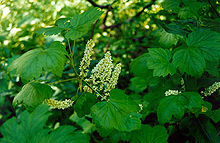- Ribes hudsonianum
-
Northern Black Currant 
R. hudsonianum growing in Clearwater National Forest Scientific classification Kingdom: Plantae (unranked): Angiosperms (unranked): Eudicots (unranked): Core eudicots Order: Saxifragales Family: Grossulariaceae Genus: Ribes Species: R. hudsonianum Binomial name Ribes hudsonianum
Richardson [1]Varieties Ribes hudsonianum is a species of currant, known by the common name northern black currant. The species is divided into two varieties,[2] each known simultaneously as northern black currants, and by their own individual common, and scientific names; the type variety, R. h. var. hudsonianum, is also known as the Hudson Bay currant;[2][4] whereas R. h. var. petiolare is also known as the western black currant.[2][3]
The only states or provinces where both varieties are present are British Columbia in Canada; and the U.S. states of Idaho and Washington.[2]
Hudson Bay currants are found in every province in Canada, from Quebec westwards; and in the U.S. in Alaska, the northern midwest (Iowa, Michigan, Minnesota, and Wisconsin), and the far northwest (Idaho and Washington).[4]
Although Western black currants are found in British Columbia, they are distributed primarily south of Canada in the western U.S. (Wyoming, Montana, Idaho, Washington, Oregon, Nevada, California, and Utah).[3]
R. hudsonianum grow in moist wooded areas, such as mountain streambanks and in swamp thickets. They are upright to erect shrubs growing one half to 2 meters tall. They are aromatic, with a strong scent generally considered unpleasant.[5] Stems are covered in shiny, yellow resin glands that lack spines or prickles. Leaves are up to 10 centimeters long, divided into three, or rarely five, sharp-toothed lobes, havig long hairs on the undersides, studded with yellow glands. Inflorescences are erect, spikelike racemes of up to 50 flowers. Each flower is roughly tubular, with the whitish sepals spreading open to reveal smaller whitish petals within. Fruits are bitter-tasting, black berries, about a centimeter wide with a waxy surface, speckled with yellow glands.
References
- ^ Species was originally described and published in Narrative of a Journey to the Shores of the Polar Sea ed. 2. 734 (-735). 1823. "Plant Name Details for Ribes hudsonianum". IPNI. http://www.ipni.org:80/ipni/idPlantNameSearch.do?id=315146-2. Retrieved July 26, 2010. "Type Information: Locality; calcareous soil, dry woods."
- ^ a b c d e "Profile for Ribes hudsonianum (northern black currant)". PLANTS Database. USDA, NRCS. http://plants.usda.gov/java/profile?symbol=RIHU. Retrieved July 26, 2010.
- ^ a b c "Profile for Ribes hudsonianum var. petiolare (western black currant)". PLANTS Database. USDA, NRCS. http://plants.usda.gov/java/profile?symbol=RIHUP. Retrieved July 26, 2010.
- ^ a b "Profile for Ribes hudsonianum var. hudsonianum (Hudson Bay currant)". PLANTS Database. USDA, NRCS. http://plants.usda.gov/java/profile?symbol=RIHUH. Retrieved July 26, 2010.
- ^ Flora of North America
External links
Categories:- Ribes
- Flora of Alaska
- Flora of California
- Flora of Iowa
- Flora of Idaho
- Flora of Michigan
- Flora of Minnesota
- Flora of Montana
- Flora of Nevada
- Flora of Oregon
- Flora of Utah
- Flora of Washington (state)
- Flora of Wisconsin
- Flora of Wyoming
- Flora of Canada
- Flora of Alberta
- Flora of British Columbia
- Flora of Manitoba
- Flora of the Northwest Territories
- Flora of Nunavut
- Flora of Ontario
- Flora of Quebec
- Flora of Saskatchewan
- Flora of Yukon
- Saxifragales stubs
Wikimedia Foundation. 2010.
